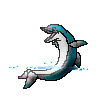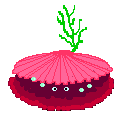|
|
|

|
 |
Designed by Elizabeth Milligan |
|

Introduction | Task | Process | Evaluation | Conclusion | Credits | Teacher Page
You are a zoologist at the San Diego zoo. Zoo visitors are very excited about visiting your zoo; however, they are sad that there are no aquarium exhibits for them to see. Your job assignment is to set up a new aquarium exhibit.
Before designing your aquarium, there are a couple of questions that you must answer. The first question is "What types of water habitats are there?" After choosing a water habitat, you need to ask "What kind of animals can live together in this habitat?"
In summary, here are the goals that you must work for to complete this mission:
Your task is to develop an aquarium for the San Diego zoo that will be the home of at least 3 animals. The aquarium must be an appropriate habitat for these animals.
There are a few different ways that you can create your aquarium. One choice is to draw a poster size version of your aquarium. Another choice is to create a diorama of your aquarium. If you prefer using the computer, you could design your aquarium using Kid Pix Deluxe or Power Point. If you prefer real life, you can create your habitat using a 10 gallon fish tank. Before designing your aquarium you need to tell the teacher your ideas for creating it.
You will need to use the reference section at the library or the internet to gather information on your habitat and the animals that live there. You will need to find information concerning the physical part of the habitat (i.e. plants, rocks, etc.), as well as the food that should be available for your animals.
Goal 1: Your first goal is to choose a water habitat. Fish can live in many environments. However, all of these environments can be classified into two major groups.
Click on the clam to discover the first type of
water habitat. Click on the fish to discover the second type of
water habitat.

|
Goal 2: Here are a few links to sites on the internet that may be helpful in your search for 3 animals that can coexist in the chosen habitat.
|
|
|
Goal 3: Your last and final goal is to design your aquarium. There are many ways that you can go about doing this:
You are not limited to these 4 examples. If you have another idea, please discuss it with your teacher. Each group must tell the teacher what they will do to design an aquarium before they begin this final project.
Your aquarium needs to include these things:
Each student will be given an oral exam at the end of this project. The oral exam will cover the first two objectives listed below. This will be an individual grade and will count for for 40% of your final grade. The final project of designing an aquarium will be a group grade and will count for 60% of your final grade.
|
Beginning 1 |
Developing 2 |
Accomplished 3 |
Exemplary 4 |
Score |
|
|---|---|---|---|---|---|
|
|
|
|
|
|
Multiply score times 1 for final score. |
|
.
|
|
|
The student can list 3 animals that live in the chosen water habitat and can identify each animal's food and home, other than water if applicable. |
|
Multiply score times 9 for final score. |
|
|
|
|
|
|
Multiply score times 15 for final score. |
Conclusion
Congratulations! You have designed an aquarium for the visitors of the San Diego zoo. In doing so, you should have learned that there are two types of water habitats and should be able to give examples of both. Hopefully, you can also identify 3 animals that live in this habitat and give examples of the types of food that they eat and areas in the water where they like to live. Finally you should have also identified specific body parts on these animals that are necessary for them to live in the water.
Now ask someone to take you to a zoo near you so that you can visit the aquarium there. Maybe you will see an aquarium that is similar to the one you designed! Look also at the other habitats represented there and try to identify each one.
Thank you to the Discovery School site for the awesome information on freshwater and saltwater habitats.
Last updated on August 15, 1999. Based on a template from The WebQuest Page